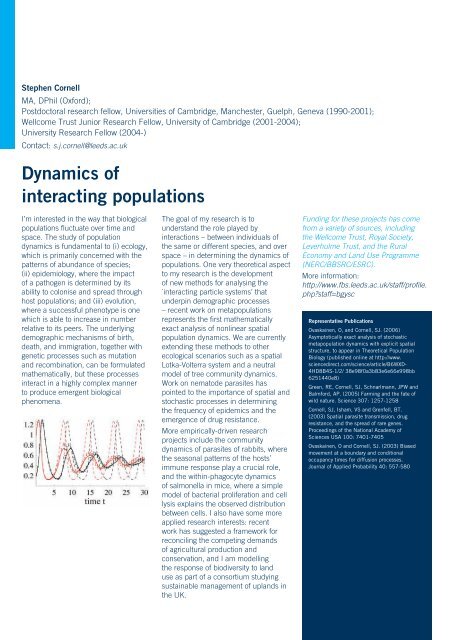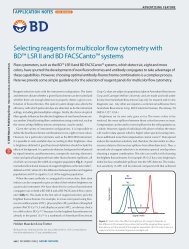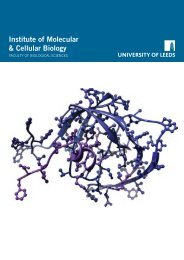3649-08 IICB.indd - Faculty of Biological Sciences - University of ...
3649-08 IICB.indd - Faculty of Biological Sciences - University of ...
3649-08 IICB.indd - Faculty of Biological Sciences - University of ...
Create successful ePaper yourself
Turn your PDF publications into a flip-book with our unique Google optimized e-Paper software.
Stephen Cornell<br />
MA, DPhil (Oxford);<br />
Postdoctoral research fellow, Universities <strong>of</strong> Cambridge, Manchester, Guelph, Geneva (1990-2001);<br />
Wellcome Trust Junior Research Fellow, <strong>University</strong> <strong>of</strong> Cambridge (2001-2004);<br />
<strong>University</strong> Research Fellow (2004-)<br />
Contact: s.j.cornell@leeds.ac.uk<br />
Dynamics <strong>of</strong><br />
interacting populations<br />
I’m interested in the way that biological<br />
populations fluctuate over time and<br />
space. The study <strong>of</strong> population<br />
dynamics is fundamental to (i) ecology,<br />
which is primarily concerned with the<br />
patterns <strong>of</strong> abundance <strong>of</strong> species;<br />
(ii) epidemiology, where the impact<br />
<strong>of</strong> a pathogen is determined by its<br />
ability to colonise and spread through<br />
host populations; and (iii) evolution,<br />
where a successful phenotype is one<br />
which is able to increase in number<br />
relative to its peers. The underlying<br />
demographic mechanisms <strong>of</strong> birth,<br />
death, and immigration, together with<br />
genetic processes such as mutation<br />
and recombination, can be formulated<br />
mathematically, but these processes<br />
interact in a highly complex manner<br />
to produce emergent biological<br />
phenomena.<br />
The goal <strong>of</strong> my research is to<br />
understand the role played by<br />
interactions – between individuals <strong>of</strong><br />
the same or different species, and over<br />
space – in determining the dynamics <strong>of</strong><br />
populations. One very theoretical aspect<br />
to my research is the development<br />
<strong>of</strong> new methods for analysing the<br />
`interacting particle systems’ that<br />
underpin demographic processes<br />
– recent work on metapopulations<br />
represents the first mathematically<br />
exact analysis <strong>of</strong> nonlinear spatial<br />
population dynamics. We are currently<br />
extending these methods to other<br />
ecological scenarios such as a spatial<br />
Lotka-Volterra system and a neutral<br />
model <strong>of</strong> tree community dynamics.<br />
Work on nematode parasites has<br />
pointed to the importance <strong>of</strong> spatial and<br />
stochastic processes in determining<br />
the frequency <strong>of</strong> epidemics and the<br />
emergence <strong>of</strong> drug resistance.<br />
More empirically-driven research<br />
projects include the community<br />
dynamics <strong>of</strong> parasites <strong>of</strong> rabbits, where<br />
the seasonal patterns <strong>of</strong> the hosts’<br />
immune response play a crucial role,<br />
and the within-phagocyte dynamics<br />
<strong>of</strong> salmonella in mice, where a simple<br />
model <strong>of</strong> bacterial proliferation and cell<br />
lysis explains the observed distribution<br />
between cells. I also have some more<br />
applied research interests: recent<br />
work has suggested a framework for<br />
reconciling the competing demands<br />
<strong>of</strong> agricultural production and<br />
conservation, and I am modelling<br />
the response <strong>of</strong> biodiversity to land<br />
use as part <strong>of</strong> a consortium studying<br />
sustainable management <strong>of</strong> uplands in<br />
the UK.<br />
Funding for these projects has come<br />
from a variety <strong>of</strong> sources, including<br />
the Wellcome Trust, Royal Society,<br />
Leverhulme Trust, and the Rural<br />
Economy and Land Use Programme<br />
(NERC/BBSRC/ESRC).<br />
More information:<br />
http://www.fbs.leeds.ac.uk/staff/pr<strong>of</strong>ile.<br />
php?staff=bgysc<br />
Representative Publications<br />
Ovaskainen, O, and Cornell, SJ. (2006)<br />
Asymptotically exact analysis <strong>of</strong> stochastic<br />
metapopulation dynamics with explicit spatial<br />
structure, to appear in Theoretical Population<br />
Biology (published online at http://www.<br />
sciencedirect.com/science/article/B6WXD-<br />
4HD8B4S-1/2/ 38e98f0a3b83e6e66e998bb<br />
6251440e8)<br />
Green, RE, Cornell, SJ, Schnarlmann, JPW and<br />
Balmford, AP. (2005) Farming and the fate <strong>of</strong><br />
wild nature. Science 307: 1257-1258<br />
Cornell, SJ, Isham, VS and Grenfell, BT.<br />
(2003) Spatial parasite transmission, drug<br />
resistance, and the spread <strong>of</strong> rare genes.<br />
Proceedings <strong>of</strong> the National Academy <strong>of</strong><br />
<strong>Sciences</strong> USA 100: 7401-7405<br />
Ovaskainen, O and Cornell, SJ. (2003) Biased<br />
movement at a boundary and conditional<br />
occupancy times for diffusion processes.<br />
Journal <strong>of</strong> Applied Probability 40: 557-580










